Morgan's Raid Route Historical Marker: Pomeroy Ohio
Introduction
Text-to-speech Audio
Images
This is side A of the marker. It tells about the raid route and who was within it.
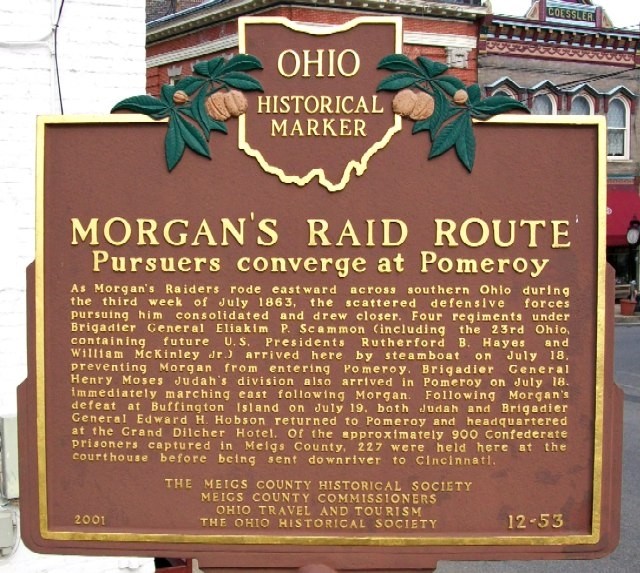
This is side B of the marker. It tells about the Meigs County Courthouse and the circumstances around its erection.
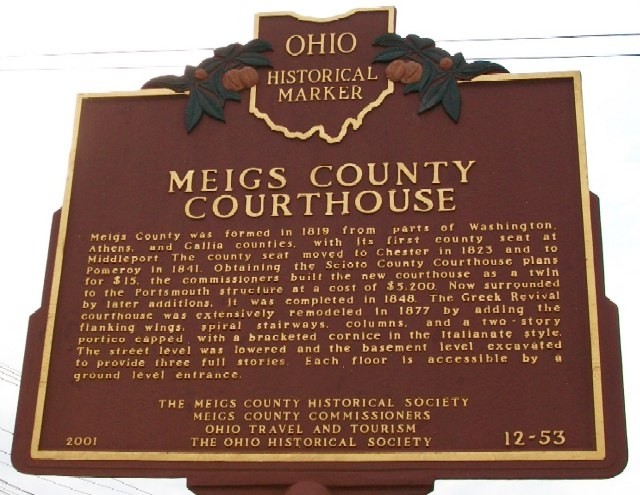
This is a photo of the marker in the location in which it stands today. (Note: There are other historical markers of significance within walking distance of this one.)

Map of the route that Morgan's raid journeyed.
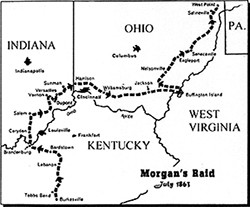
Photo of John Hunt Morgan, the leader of Morgan's Raid.
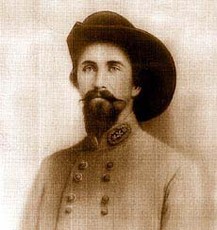
Article of Morgan's Raiders entering Washington,Ohio, from Harper's Weekly, Saturday, August 15, 1863.
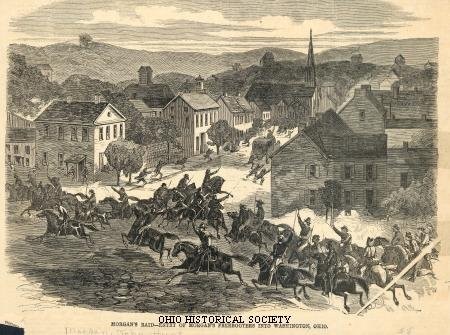
Major General Ambrose Burnside
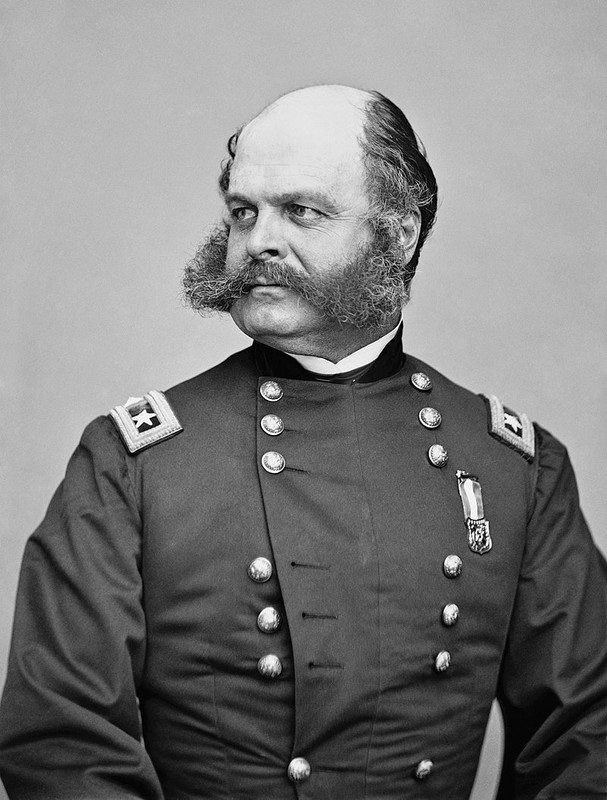
Brigadier General Henry M. Judah
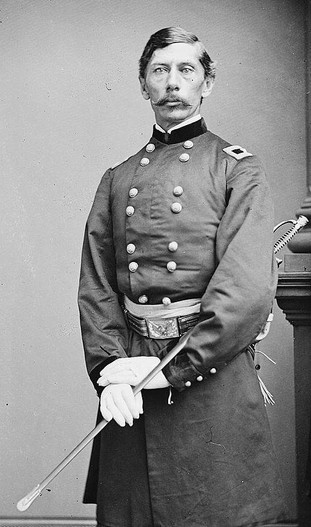
Site of the deaths of Holiday Hysell and Dr. William Hudson
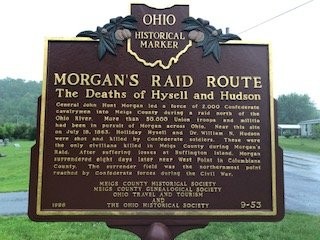
Backstory and Context
Text-to-speech Audio
Morgan’s Raid comes from the invasion of Morgan’s raiders which were Confederate cavalry in the Northern states during the Civil War. These raiders converged in Pomeroy, Ohio in the summer of 1863. General John Hunt Morgan was the man to show Ohioans just how unprepared they were for a fight. Morgan's superior was General Braxton Bragg and he commanded Morgan to take his men and raid any area of Kentucky he saw fit in an attempt to capture Louisville. This devious plan was put in place to divert General Ambrose Burnside who was in Cincinnati and delay his plan on invading Tennessee.
July of 1863 saw Morgan’s men launching their plan from Burkesville, Kentucky. During their journey, they commandeered two steamboats and crossed over into Indiana. As Morgan moved into Indiana, he ordered his men to spread false rumors that they were going to attack Indianapolis. Instead, they stayed in southern Indiana gathering horses and supplies from union civilians. Morgan had been ordered not to cross the Ohio River, but he was determined to find a place to ford the Ohio River. In a small town just west of Cincinnati, Ohio, called Harrison, his troops were resting and in the middle of the night, they disappeared. The men had gone off to start skirmishes with the locals and they also set fire to a few wagons. There was a recorded time where the raiders had killed two civilians. Shortly after entering Meigs County the raiders had shot and killed Holiday Hysell and Dr. William N. Hudson. These would be the only civilians killed in Meigs County during the raid. The journey went on; they rode through Batavia to Williamsburg with the men from the Harrison camp hot on their trail.
The moment the raiders had entered Ohio, Governor David Tod sent out a proclamation for every Ohio militiamen to help protect the southern counties. The proclamation did not reach the militia in time but eventually, 60,000 men were mustered. The militiamen from Ohio were no match compared to the experience Morgan had gotten in previous battles of the war. Colonel Richard Morgan, the General’s brother, led a separate group of troops south passing Ripley, West Virginia and back up through Locust Grove to rejoin the others. This is where the troops would head south and converge in Pomeroy, Ohio in July of 1863. In downtown Pomeroy, Morgan’s men would pillage and ransack stores. Amazingly, they left most of the farms and houses alone. There was a recorded time where the raiders had killed two civilians. Shortly after entering Meigs County the raiders had shot and killed Holiday Hysell and Dr. William N. Hudson. These would be the only civilians killed in Meigs County during the raid. After encountering heavy resistance from Ohio militia and Union soldiers, Morgan started searching for a way to cross the Ohio River into West Virginia. He chose a low ford on the river in Portsmouth just north of Pomeroy near Buffington Island.
Once Morgan had reached the ford he discovered a small detachment of militia guarding the ford. The militia, being severely outnumbered, decided to retreat under the cover of darkness. Morgan planned to cross the ford immediately but due to the river flooding, he was delayed. This allowed Union Brigadier General Edward H. Hobson and his 2,800 strong cavalry division to catch up with Morgan. Hobson had been closely following Morgan from Kentucky. Union Major General Ambrose Burnside had also sent a cavalry brigade of 1,100 men under the command of Brigadier General Henry M. Judah. Several gunboats under the command of Lieutenant Commander LeRoy Fitch were also traveling up the river toward Morgan. An infantry division under the command of Brigadier General Eliakim P. Sammon was sent to guard the towns of Gallipolis and Pomeroy from any other possible attacks. These men had been with the militia skirmishing with Morgan throughout his raid. Among these men were Colonel Rutherford B. Hayes and Lieutenant William McKinley Jr., both of whom would later be elected to the presidency of the United States. Morgan was able to ford a small group of men across the river until General Judah unexpectedly appeared out of the fog at ruffly 5:30 in the morning.
The battle then ensued, the combined Union forces numbering close to 3,000 troops and Morgan only having around 1,800 men left. Judah's men were surprised by the sudden arrival of Confederate soldiers and were quickly routed. However, Judah was able to regroup and lead a successful counter-attack forcing Morgan to retreat a mile and a half up river. The Union forces had the advantage of cannons which they used to deadly effect. Commander Fitch's two gunboats, USS Moose and Allegheny Belle, continuously fired their cannons as Morgan's forces retreated upriver. Morgan decided to make a stand in an L-shaped formation while his rearguard retreated further north. Colonel Hayes' infantry brigade reached the battle via steamboat and acted as reserves for Judah's cavalry. After a two-hour long battle, Morgan and his raiders were forced to continue their retreat.
After the defeat of Morgan’s troops at Buffington Island, both Brigadier General Henry Moses Judah and Brigadier General Edward Hobson returned to Pomeroy to headquarter at the Grand Dilcher Hotel. The more than 900 Confederate soldiers that were captured after the defeat at Buffington Island were held at the Meigs County Courthouse before being transported to Cincinnati. Morgan was eventually captured and sent to the Ohio Penitentiary where he would later escape. Today, this marker is a reminder of the way that the Civil War touched this small community on the Ohio River.
Sources
“Morgan's Raid.” Morgan's Raid - Ohio History Central, www.ohiohistorycentral.org/w/Morgan%27s_Raid.
